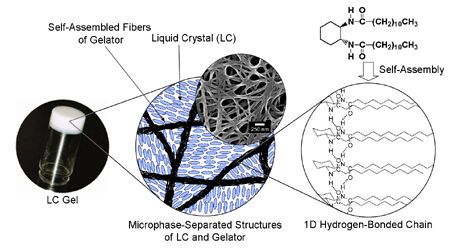
Physical gels are soft solid materials formed by the fibrous aggregation of low molecular weight gelators in solvents.
Recently we have succeeded in the preparation of liquid-crystalline (LC) physical gels by using liquid crystals as solvents for physical gelation. The LC gels are microphase-separated materials consisting of LC solvents and fibrous solid aggregates of gelators.
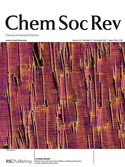
We have found that physical gelation of liquid crystals leads to the formation of a variety of self-organized structures and to the induction of significant properties as follows:
-
Improved response speeds of room temperature liquid crystals to electric fields can be achieved by the physical gelation of the materials in twisted nematic (TN) cells which are widely used for liquid crystal displays. In these cells. (For example: Refs. 12, 25)
-
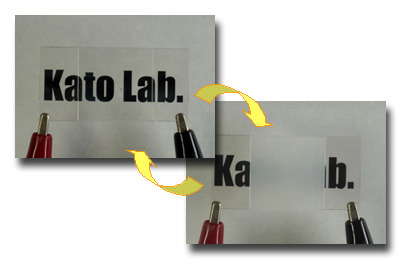 Nematic LC gels suitable for light scattering displays have been prepared by forming finely dispersed networks in nematic liquid crystals. The LC gels show fast and high contrast electrooptic switching between turbid and transparent states. (For example: Refs. 13, 15, 16, 18)
Nematic LC gels suitable for light scattering displays have been prepared by forming finely dispersed networks in nematic liquid crystals. The LC gels show fast and high contrast electrooptic switching between turbid and transparent states. (For example: Refs. 13, 15, 16, 18)
-
Physical gelation of smectic liquid crystals results in the formation of layered phase-separated structures. Fibrous aggregates of gelators are oriented in the direction parallel to the smectic layers due to the template effects of the smectic liquid crystals. (For example: Ref. 10, 22)
-
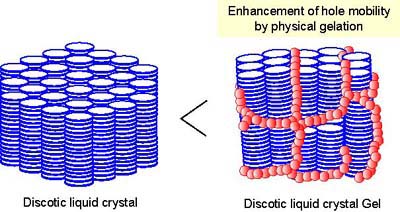 Discotic liquid crystals with aromatic cores exhibit charge carrier transport in their columnar LC states. We have found that the hole mobility of discotic liquid crystals is enhanced by the physical gelation with hydrogen-bonded networks. (For example, Ref. 4, 17)
Discotic liquid crystals with aromatic cores exhibit charge carrier transport in their columnar LC states. We have found that the hole mobility of discotic liquid crystals is enhanced by the physical gelation with hydrogen-bonded networks. (For example, Ref. 4, 17)
-
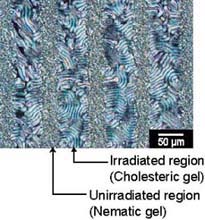 Photoinduced reversible structural changes of anisotropic physical gels are applied to rewritable patterning. The change between a nematic gel and a cholesteric gel via cholesteric liquid crystalline sol state is induced by trans-cis photoisomerization of the azobenzene moieties comprised in a chiral hydrogen-bonded gelator in a nematic liquid crystal. (For example: Ref. 11, 14)
Photoinduced reversible structural changes of anisotropic physical gels are applied to rewritable patterning. The change between a nematic gel and a cholesteric gel via cholesteric liquid crystalline sol state is induced by trans-cis photoisomerization of the azobenzene moieties comprised in a chiral hydrogen-bonded gelator in a nematic liquid crystal. (For example: Ref. 11, 14)
-
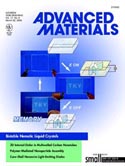 The alignment of nematic liquid crystals in electric fields is memorized by incorporating small amounts of self-assembled fibers into the nematic liquid crystals. Hydrogen-bonded fibrous aggregates formed in electrically aligned nematic phases direct liquid-crystal alignment after removal of the electric fields. Rewritable bistable nematic materials exhibiting light-scattering and transparent states have been achieved by a combination of thermal and electric stimuli.
(For example: Ref. 10)
The alignment of nematic liquid crystals in electric fields is memorized by incorporating small amounts of self-assembled fibers into the nematic liquid crystals. Hydrogen-bonded fibrous aggregates formed in electrically aligned nematic phases direct liquid-crystal alignment after removal of the electric fields. Rewritable bistable nematic materials exhibiting light-scattering and transparent states have been achieved by a combination of thermal and electric stimuli.
(For example: Ref. 10)
-
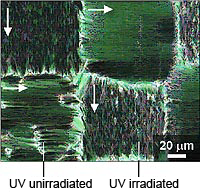 Self-assembled fibers formed by gelators with polymerizable groups are oriented in liquid crystals and immobilized by following photopolymerization. The anisotropic structure allows control of liquid crystalline alignment.
(For example: Ref. 6)
Self-assembled fibers formed by gelators with polymerizable groups are oriented in liquid crystals and immobilized by following photopolymerization. The anisotropic structure allows control of liquid crystalline alignment.
(For example: Ref. 6)
-
Random dispersed fibrous networks are immobilized in liquid crystals by photopolymerization of gelators having polymerizable moieties after the self-assembly. The polymerized LC gels are stabilized and exhibit highly durable electrooptical switching between scattering and transmittance states. (For example: Ref. 2, 3)

(Some of the low molecular weight gelators used in our studies have been developed by Professor K. Hanabusa at Shinshu University.)
Selected papers on this subject:
-
Liquid-Crystalline Gels
Kazuhiro Yabuuchi and Takashi Kato
Handbook of Liquid Crystals 2nd Edition, (Eds. John W. Goodby, Peter J. Collings, Takashi Kato, Carsten Tschierske, Helen Gleeson, and Peter Raynes) Wiley-VCH Verlag GmbH & Co. KGaA, Vol. 6, p. 1-25 (2014). -
Liquid-Crystalline Gels Exhibiting Electrooptical Light Scattering Properties: Fibrous Polymerized Network of a Lysine-Based Gelator Having Acrylate Moieties
Hiroki Eimura, Masafumi Yoshio, Yoshiko Shoji, Kenji Hanabusa, and Takashi Kato
Polym. J., 44, 594-599 (2012). (Special Issue) -
Self-Assembled Fibers Photopolymerized in Nematic Liquid Crystals: Stable Electrooptical Switching in Light-Scattering Mode
Yuki Hirai, Norihiro Mizoshita, Masaya Moriyama, and Takashi Kato
Langmuir, 25, 8423 (2009). (Special issue on Molecular and Polymer Gels: Materials with Self-Assembled Fibrillar Networks) -
Enhanced Hole Transporting Behavior of Discotic Liquid-Crystalline Physical Gels
Yuki Hirai, Hirosato Monobe, Norihiro Mizoshita, Masaya Moriyama, Kenji Hanabusa, Yo Shimizu, and Takashi Kato
Adv. Funct. Mater., 18, 1668 (2008). -
Liquid-Crystalline Physical Gels (Review)
Takashi Kato, Yuki Hirai, Suguru Nakaso, and Masaya Moriyama
Chem. Soc. Rev., 36, 1857 (2007). [BACK COVER] -
Liquid-Crystal Composites Composed of Photopolymerized Self-Assembled Fibers and Aligned Smectic Molecules
Norihiro Mizoshita and Takashi Kato
Adv. Funct. Mater., 16, 2218 (2006). -
Functional Liquid-Crystalline Assemblies: Self-Organized Soft Materials (Review)
Takashi Kato, Norihiro Mizoshita, and Kenji Kishimoto
Angew. Chem. Int. Ed., 45, 38 (2006). -
Gelation of Liquid Crystals with Self-Assembled Fibers (Review)
Takashi Kato, Norihiro Mizoshita, Masaya Moriyama, and Tetsu Kitamura
Top. Curr. Chem., 256, 219 (2005). -
Electroactive Supramolecular Self-Assembled Fibers Comprises of Doped Tetrathiafulvalene-Based Gelators
Tetsu Kitamura, Suguru Nakaso, Norihiro Mizoshita, Yusuke Tochigi, Takeshi Shimomura, Masaya Moriyama, Kohzo Ito, and Takashi Kato
J. Am. Chem. Soc., 127, 14769 (2005). -
Bistable Nematic Liquid Crystals with Self-Assembled Fibers
Norihiro Mizoshita, Yuki Suzuki, Kenji Hanabusa, and Takashi Kato
Adv. Mater., 17, 692 (2005). -
Photopatterning of Discotic Liquid-Crystalline Gels
Masaya Moriyama, Norihiro Mizoshita, and Takashi Kato
Polym. J., 36, 661 (2004). -
Fast and High-Contrast Electro-Optical Switching of Liquid-Crystalline Physical Gels: Formation of Oriented Microphase-Separated Structures
N. Mizoshita, K. Hanabusa, and T. Kato
Adv. Funct. Mater., 13, 313 (2003). -
Homeotropically Oriented Nematic Physical Gels for Electrooptical Materials
Y. Suzuki, N. Mizoshita, K. Hanabusa, and T. Kato
J. Mater. Chem., 13, 2870 (2003). -
Photoresponsive Anisotropic Soft Solids: Liquid-Crystalline Physical Gels Based on a Chiral Photochromic Gelator
M. Moriyama, N. Mizoshita, T. Yokota, K. Kishimoto, and T. Kato
Adv. Mater., 15, 1335 (2003). -
Light Scattering Electrooptic Behavior of Liquid-Crystalline Physicail Gels - Effects of Microphase-Separated Morphologies
Norihiro Mizoshita, Yuki Suzuki, Kenji Kishimoto, Takashi Kato, and Kenji Hanabusa
Mol. Cryst. Liq. Cryst., 409, 175 (2004). -
Self-Assembly of Phase-Segregated Liquid Crystal Structures (Review)
Takashi Kato
Science, 295, 2414 (2002). -
The Positive Effect on Hole Transport Behaviour in Anisotropic Gels Consisting of Discotic Liquid Crystals and Hydrogen-Bonded Fibres
Norihiro Mizoshita, Hirosato Monobe, Masaaki Inoue, Masakatsu Ukon, Tsuyoshi Watanabe, Yo Shimizu, Kenji Hanabusa, and Takashi Kato
Chem. Commun., 2002, 428. -
Electrooptical Properties of Liquid-Crystalline Physical Gels: A New Oligo(Amino Acid) Gelator for Light Scattering Display Materials
N. Mizoshita, Y. Suzuki, K. Kishimoto, K. Hanabusa, and T. Kato
J. Mater. Chem., 12, 2197 (2002). -
Hydrogen-Bonded Liquid Crystalline Materials: Supramolecular Polymeric Assembly and the Induction of Dynamic Function (Review)
Takashi Kato, Norihiro Mizoshita, and Kiyoshi Kanie
Macromol. Rapid Commun., 22, 797 (2001). -
Liquid-Crystalline Physical Gels: Self-Aggregation of a Gluconamide Derivative in Mesogenic Molecules for the Formation of Anisotropic Functional Composites
Kazuhiro Yabuuchi, Alan E. Rowan, Roeland J. M. Nolte, and Takashi Kato
Chem. Mater., 12, 440 (2000). -
Liquid Crystalline Physical Gels: Electrooptic Properties and Microphase-Separated Structures
Norihiro Mizoshita, Takaaki Kutsuna, Kenji Hanabusa, and Takashi Kato, Proc. SPIE-Int. Soc. Opt. Eng., 4107, 108 (2000). -
Smectic Liquid-Crystalline Physical Gels. Anisotropic Self-Aggregation of Hydrogen-Bonded Molecules in Layered Structures
Norihiro Mizoshita, Takaaki Kutsuna, Kenji Hanabusa, and Takashi Kato
Chem. Commun., 1999, 781. -
Self-Aggregation of an Amino Acid Derivative as a Route to Liquid-Crystalline Physical Gels - Faster Response to Electric Fields
Norihiro Mizoshita, Kenji Hanabusa, and Takashi Kato
Adv. Mater., 11, 392 (1999). -
Thermoreversible Self-Organized Gels of a Liquid Crystal Formed by Aggregation of Trans-1,2-Bis(Acylamino)Cyclohexane Containing a Mesogenic Moiety
Takashi Kato, Gohta Kondo, and Kenji Hanabusa
Chem. Lett., 1998, 193. -
Gelation of Room-Temperature Liquid Crystals by the Association of a Trans-1,2-Bis(Amino)Cyclohexane Derivative
Takashi Kato, Takaaki Kutsuna, Kenji Hanabusa, and Masakatsu Ukon
Adv. Mater., 10, 606 (1998).